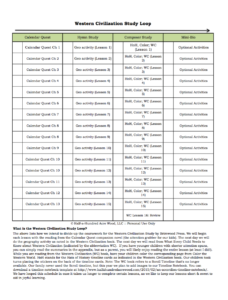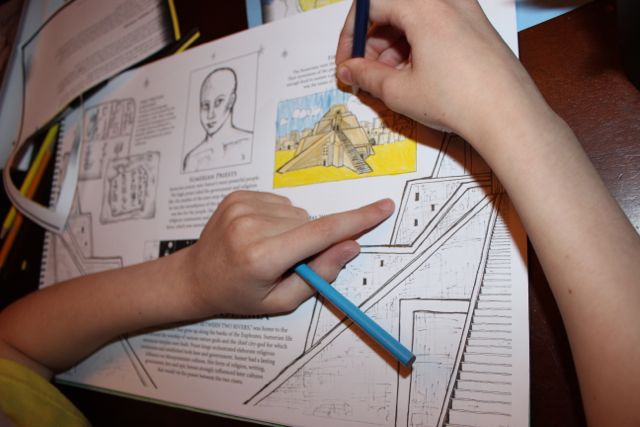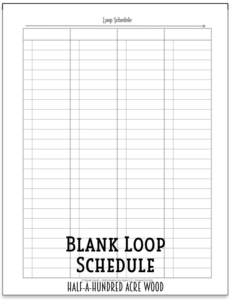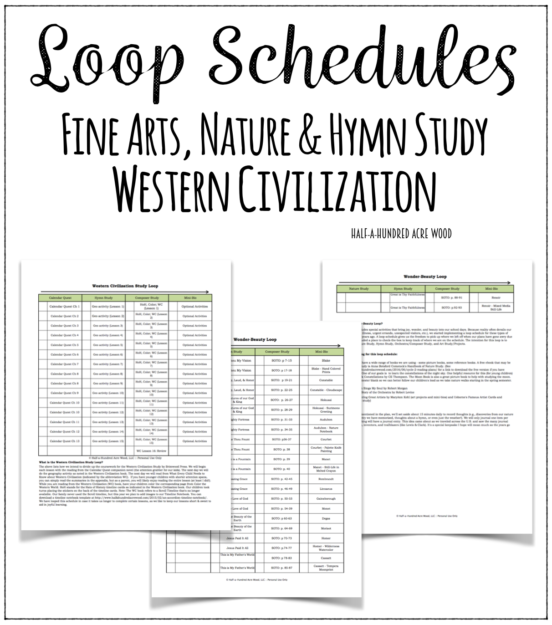
We wanted to take a moment to share our loop schedules of the past with you, but when our family returns to a study of world empires, we will be using a different reading plan called Mission: World Wonders, a study that incorporates a cohesive, integrated study of missions, geography, hymns, and science, along with a chronological study of history from ancient times through the rise of the Renaissance period.
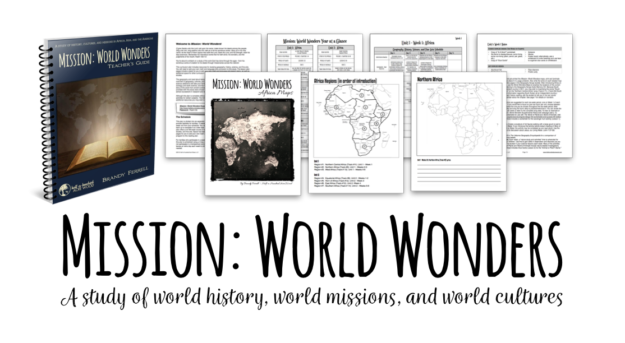 (For those who are using Mission: World Wonders, a loop schedule specific to our study is available to you on the Mission: World Wonders Supplemental Resource Page.) But because our previous loop schedules have been so popular, we’ve decided to also provide a couple of simple loop schedule options for families who are not using Mission: World Wonders.
(For those who are using Mission: World Wonders, a loop schedule specific to our study is available to you on the Mission: World Wonders Supplemental Resource Page.) But because our previous loop schedules have been so popular, we’ve decided to also provide a couple of simple loop schedule options for families who are not using Mission: World Wonders.
What Is a Loop Schedule?
Loop scheduling is simply a way of planning. In a loop schedule, you cycle through subjects in a loop instead of doing them on a certain day each week. For example, in a normal block schedule, I can set aside Wednesday afternoons for nature study, Thursday afternoons for composer study, and Friday afternoons for art projects. But… if our schedule is interrupted due to unforeseen circumstances, we will either totally miss what we planned to do for a particular subject that week or have to double up the next week to “catch up.”
If I use a hymn-composer-art loop schedule, we can cycle through those tasks without worrying about totally missing out on Art Friday, for example. If we don’t get around to art on Friday, we’ll just do it on Monday. Even though we may have a reading plan with assigned tasks for hymn study, composer study, and art study each week, we can often fall “behind schedule” because of things like illness, drama rehearsals, field trips, or Distractible Mom Syndrome. In this case, we just pick up where we left off the next day and don’t worry about not completing that task on a particular day.
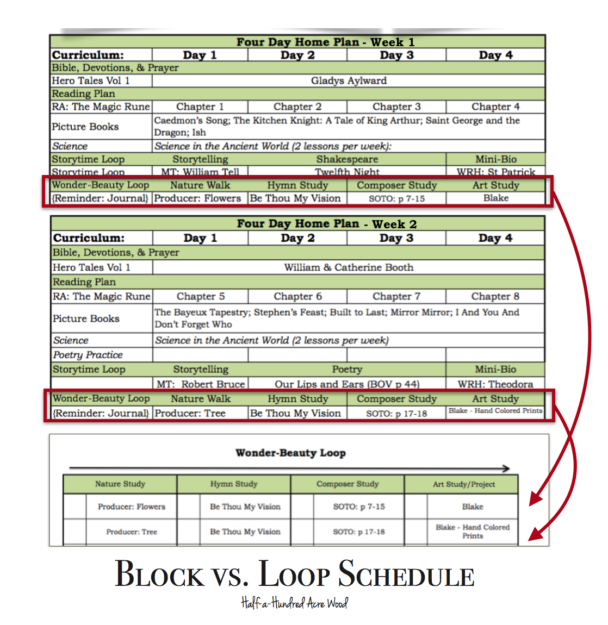
If you compare the loop schedules at the bottom of the image to the reading plan above it, you’ll see that it goes in the same order. (We also handle our read alouds in much the same way.)
Our Loop Schedules for Nature Study, Hymn Study, Orchestra/Composer Study, and Art Study/Projects
First, there’s a study we’ve used in the past that travels through 5,000 years of history in 16 lessons, the Western Civilization Study by Brimwood Press. <—- You need to take a look at this! It was a great overview of world history for us!
What is the Western Civilization Study Loop?
The above document lists how we divided up the coursework for the Calendar Quest Western Civilization Study. We began each lesson with the reading from the Calendar Quest companion novel (the attention grabber for our kids). The next day we worked on the geography activity as noted in the Western Civilization book. On another day we read from What Every Child Needs to Know about Western Civilization (indicated by the abbreviation WC). If you have younger children with shorter attention spans, you can simply read the summaries in the appendix, but as a parent, you will likely enjoy reading the entire lesson (at least I did!). While you are reading from the Western Civilization (WC) book, children can color the corresponding page from Color the Western World. HoH stands for the Hats of History timeline cards as indicated in the Western Civilization book. Our children took turns placing the stickers on the back of the timeline cards. [Note: The WC book refers to a Scroll Timeline that’s no longer available. Instead, you can add images to a Timeline Notebook.]
Download the Western Civilization Study Loop (…if you’re using the Calendar Quest Western Civilization Study by Brimwood Press. If you aren’t, instead of using this plan you can simply read a couple of chapters per week out of a volume of Story of the World or another world history book.)
What is the Wonder-Beauty Loop?
This loop schedule cycles through Nature Study, Hymn Study, Orchestra/Composer Study, and Art Study/Projects. These are special activities that bring joy, wonder, and beauty into our school days. Again, because reality often derails our school plans, we use a loop schedule which gives us the freedom to pick up where we left off when our plans are interrupted. I’ve included a place to check-the-box to keep track of where you are on the schedule. (But let me emphasize that it’s not about checking the box – it’s about keeping track of where you are!)
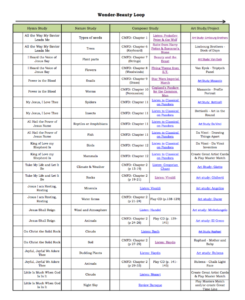 Download the Wonder-Beauty Loop.
Download the Wonder-Beauty Loop.
For Classical Conversations families, the two loop schedules above would work nicely with Cycle 1. The only thing that makes the Wonder-Beauty Loop related to Cycle 1 is the arrangement of artists and composers studied at certain points in the school year. It also includes nature study prompts for biology and earth science. This schedule can be used for families regardless of whether they are using Classical Conversations®.
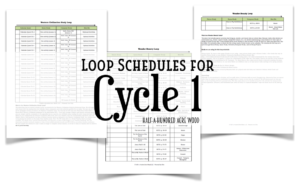
Books used for the Wonder-Beauty Loop
Note: Shopping at Amazon through our links provides a way to compensate us for the time we’ve invested in developing this for you. Please consider shopping through Amazon through our website whenever you can. We greatly appreciate your thoughtfulness in doing so – it keeps our website running and coffee in the coffee pot.





Hymn Study: Then Sings My Soul by Robert Morgan
Composer Study: Classical Music for Dummies by Pogue & Speck, along with on-line links to listen to classical music. This is not our favorite book on classical music, but it’s what Classical Conversations® uses in the Foundations program.
Art Study: Discovering Great Artists by MaryAnn Kohl (art projects and mini-bios) along with Usborne’s Famous Paintings Cards when possible and wikiart.org. (Use the wikiart website with caution! Some artists painted provocative images of the human body.)
Journaling
Although it’s not mentioned in the plan, we set aside about 15 minutes daily to record thoughts (e.g., discoveries from our nature walk, copy the poetry we have memorized, thoughts about a hymn, or even just the weather!). We only journaled one item per day, so not everything had a journal entry. This idea came about as we traveled across the U.S. and saw the many journal entries of pioneers, inventors, and trailblazers (like Lewis & Clark). It’s a special keepsake I hope will mean much as the years go by.
Other Non-Loopy Stuff Like Latin & Map Practice
Latin: Not only do our children (grades 4+) enjoy Visual Latin, I do, too. I’m finally learning Latin after all these years because Dwane Thomas helps me to enjoy it.
Map Practice: Not only do we practice the locations of our memory work, but we’ve also been working on drawing blob maps and tracing/labeling a certain continent each year. This year, we will be focusing primarily on tracing Africa and South America. You can find blob map templates here and a free map-tracing download at Map Tracing with a Printable World Atlas.
Finally, if you’d like to create your own loop schedule, download a blank one. PDF | XLS
That’s loopiness in a nutshell. We hope this helps to incorporate the lovely things into your school days!
Finally, brethren, whatsoever things are true, whatsoever things are honest, whatsoever things are just, whatsoever things are pure, whatsoever things are lovely, whatsoever things are of good report; if there be any virtue, and if there be any praise, think on these things. Philippians 4:8 (KJV)

